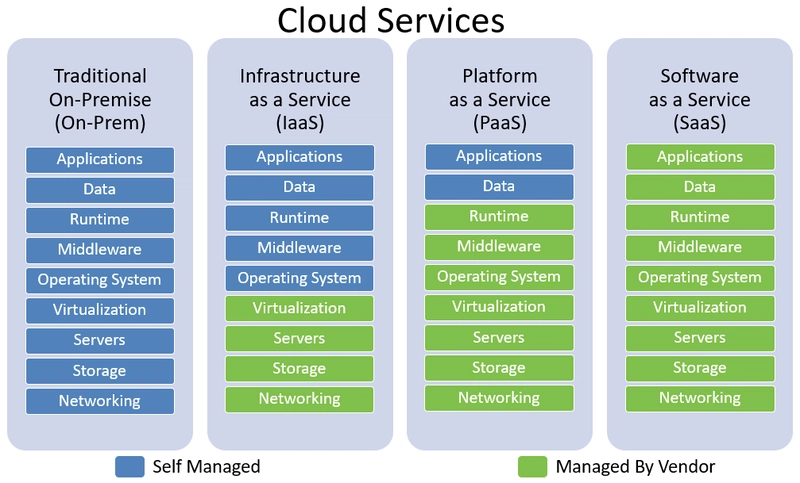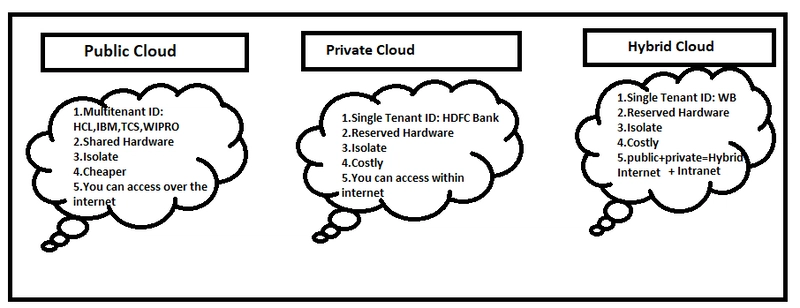This blog is in continuation of the last blog. Incase you have missed it, you can check it out here-
https://dev.to/mayankcse/basic-terms-to-know-before-getting-started-with-cloud-27m6
Difference btw On-premise and cloud computing
- On-premise Solution has all the required physical devices installed in the computer premises. Cloud Solution on the other hand, are accessed via the internet, and typically hosted by third party vendors.
- Second big difference is the "Pay-As-You-Go" or On-Demand-Service model(cloud) versus the traditional upfront capital expenditure (On-Premise).
- In cloud computing, Low CAPEX cost. No hardware costs while in on premise The larger the enterprise, the greater the CAPEX costs.
Types of cloud services
Cloud services are divided into three main categories:

Infrastructure-as-a-service (laaS): The most important and widely used category of cloud computing services. With laaS, you can rent IT infrastructure-servers and virtual machines (VMS), storage, networks and operating systems from a cloud provider on a pay-as-you-go basis.
Platform as a service (PaaS): Platform-as-a-service (PaaS) refers to cloud computing services that supply an on-demand environment for developing, testing, delivering and managing software applications. PaaS is designed to make it easier for developers to quickly create web or mobile apps, without worrying about setting up or managing the underlying infrastructure of servers, storage, network and databases needed for development.
Software as a service (SaaS): Software-as-a-service (SaaS) is a method for delivering software applications over the internet on demand and typically on a subscription basis. With SaaS, cloud
providers host and manage the software application and underlying infrastructure, and handle any maintenance, like software upgrades and security patching. Users connect to the application over the Internet, usually with a web browser on their phone, tablet or PC.

Overview of Cloud technology
Cloud Computing is the delivery of computing services-servers, storage, databases, networking, software, analytics and more-over the internet (the cloud).
Public, private, and hybrid clouds
Public cloud: Public clouds are owned and operated by a third-party cloud service provider, which deliver the computing resources like servers and storage over the internet. Microsoft Azures is an example of a public cloud. With a public cloud, all hardware, software and other supporting infrastructure are owned and managed by the cloud provider. You access these services and manage your account using a web browser.
Advantages of public clouds:
Lower costs—no need to purchase hardware or software, and you pay only for the service you use.No maintenance—your service provider provides the maintenance.Near-unlimited scalability—on-demand resources are available to meet your business needs.High reliability—a vast network of servers ensures against failure.
Private cloud :A private cloud refers to cloud computing resources and exclusively by a single business or organization. A private cloud can be physically located on the company's on-site datacenter. Some companies also pay third-party service providers to host their private cloud. A private cloud is one in which the services and infrastructure are maintained on a private network.
Advantages of a private cloud:
More flexibility—your organization can customize its cloud environment to meet specific business needs.More control—resources are not shared with others, so higher levels of control and privacy are possible.More scalability—private clouds often offer more scalability compared to on-premises infrastructure.
Hybrid Cloud: Hybrid cloud combine public and private clouds, bound together by technology that allows data and applications to be shared between them. By allowing data and applications to move between private and public clouds, hybrid cloud gives businesses greater flexibility and more deployment options.
Advantages of the hybrid cloud:
Control—your organization can maintain a private infrastructure for sensitive assets or workloads that require low latency.Flexibility—you can take advantage of additional resources in the public cloud when you need them.Cost-effectiveness—with the ability to scale to the public cloud, you pay for extra computing power only when needed.Ease—transitioning to the cloud doesn’t have to be overwhelming because you can migrate gradually—phasing in workloads over time.
This was all about this week. Next week onwards we'll be exploring Azure Portal, getting familiar with the following topics:
* How to Create a Microsoft Azure Account?
* What is a Resource group?
* How to create a Resource Group?




Top comments (0)